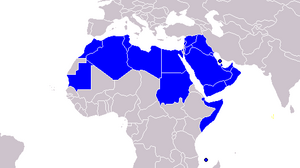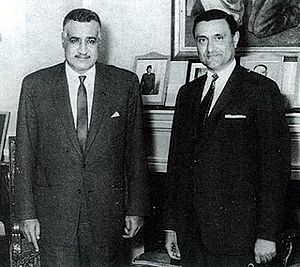Pan-Arabism facts for kids
Pan-Arabism is a political movement and idea that suggests all Arabs should come together to form one big country or state. This idea first appeared in the late 1800s and early 1900s. Pan-Arabism became very popular in the 1950s, especially with leaders like Egypt's President Gamal Abdel Nasser. People who support Pan-Arabism believe that all countries with Arab populations should unite. They also think that Western countries, like the United States or Great Britain, should not have political power in North Africa or the Arabian Peninsula.
Contents
What is Pan-Arabism?
Pan-Arabism is a belief that all Arab people share a common history, language, and culture. Because of these shared things, many believe they should live together in one strong, united nation. This idea aims to create a powerful Arab world, free from outside control.
How the Idea Started
In the late 1800s, the Ottoman Empire ruled most of the Middle East. This region was home to many different groups of people. By 1900, the Ottoman Empire was getting weaker. Many groups living there wanted to create their own independent governments.
Arabs were one of these groups. Educated Arab students and professors at places like Al-Azhar University started sharing ideas about a united Arab community. They published magazines and formed clubs. These ideas quickly spread across Arab areas that were once part of the Ottoman Empire. In 1913, Arab groups from all over the Middle East met in Paris, France, for the first Arab Congress. They talked about breaking free from the Ottoman Empire and forming Arab-led countries.
The Ottoman Empire did not like these ideas. They punished Arab nationalists, putting some in jail and even killing others.
Pan-Arabism After World War One
During World War I, many Arab groups supported the Allied powers against the Ottoman Empire. When the war ended, the Ottoman Empire fell apart. The Allied Powers then decided what would happen to the land the Ottomans used to control. Even though Arabs helped the Allies, many Arab countries were not given their freedom right away. Still wanting independence, Arabs in these occupied lands began to develop ideas for a free Arab state. These ideas became the foundation of Pan-Arabism.
Key Ideas of Pan-Arabism
After World War One, many Arab scholars and students wrote about Arab history. One writer, Darwish-Al Maqdidi, wrote a school textbook. This book explained the early beliefs of the Pan-Arab movement. It was used in many schools across the Arab Middle East. The textbook suggested that the Arab homeland was not just the Arabian Peninsula. It included anywhere Arabs lived.
Miqdadi and other scholars also believed that a free and united Arab nation could only exist if Western influence was removed from the Arab Middle East. These core beliefs became the main ideas of Pan-Arabism.
Attempts to Unite Arab Nations
Pan-Arabism became more popular after many Arab countries gained independence in the 1940s and 1950s. Egyptian President Gamal Abdel Nasser (who was president from 1956 to 1970) was a strong supporter of Pan-Arab nationalism. Nasser believed that the Arab world in both North Africa and the Arabian Peninsula should unite. This was because many of these countries shared a common culture, religion, and language.
During his time as president, Nasser helped create the United Arab Republic with Syria. This republic lasted for three years. It broke apart mainly because Nasser tried to change the Syrian and Egyptian economies too quickly. Also, many Syrians did not like that Nasser wanted to control too much government power from Egypt.
After the United Arab Republic failed, Nasser tried to get other Arab countries to join the Pan-Arab cause. In the Six-Day War in 1967, Nasser led a group of Arab countries (Syria, Lebanon, Jordan, and Iraq) to fight Israel. Israel won the war. This defeat was a major setback for Nasser's efforts to create a united Arab Middle East.
The Rise and Fall of Pan-Arabism
Why Pan-Arabism Declined
After the Six-Day War, Egypt's role as the leader of the Pan-Arab movement became much weaker. Other Arab nationalist groups started to focus on their own goals, separate from Egypt. Palestinians, for example, began to form their own movement centered on Palestinian nationalism, not Pan-Arabism. Also, Gamal Nasser's sudden death in 1970 left the Pan-Arab movement without a clear leader.
A New Kind of Pan-Arabism
Since the late 1970s, many experts thought Pan-Arabism was gone. Some believed it ended because Gamal Nasser, its main leader, lost support after the Arab defeat in the Six-Day War. Also, other Arab groups, like the Palestinians, lost faith in the movement and went their own way.
However, after the Arab Spring events in 2011, some scholars and journalists say that Pan-Arabism is coming back in new ways. Susan De Muth suggests that the Pan-Arabism of the Arab Spring is different from before. She says that Nasser's Pan-Arabism wanted to keep the Arab world free from foreign influence. Today's Pan-Arabism is mostly led by young people. They want to make Arab governments less controlling.
This new form of Pan-Arabism has been helped by technology, like social media. Protesters from different countries have been able to share their ideas and even plan protests together using social media. Other experts are not as hopeful. Marc Lynch suggests that the Arab Spring protests were expected. He believes that political movements in the Arab Middle East have been slowly growing stronger for the last thirty years.
Images for kids
-
Under Egyptian President Gamal Abdel Nasser, Pan-Arabism was very important in the 1950s and 1960s.
See also
 In Spanish: Panarabismo para niños
In Spanish: Panarabismo para niños






